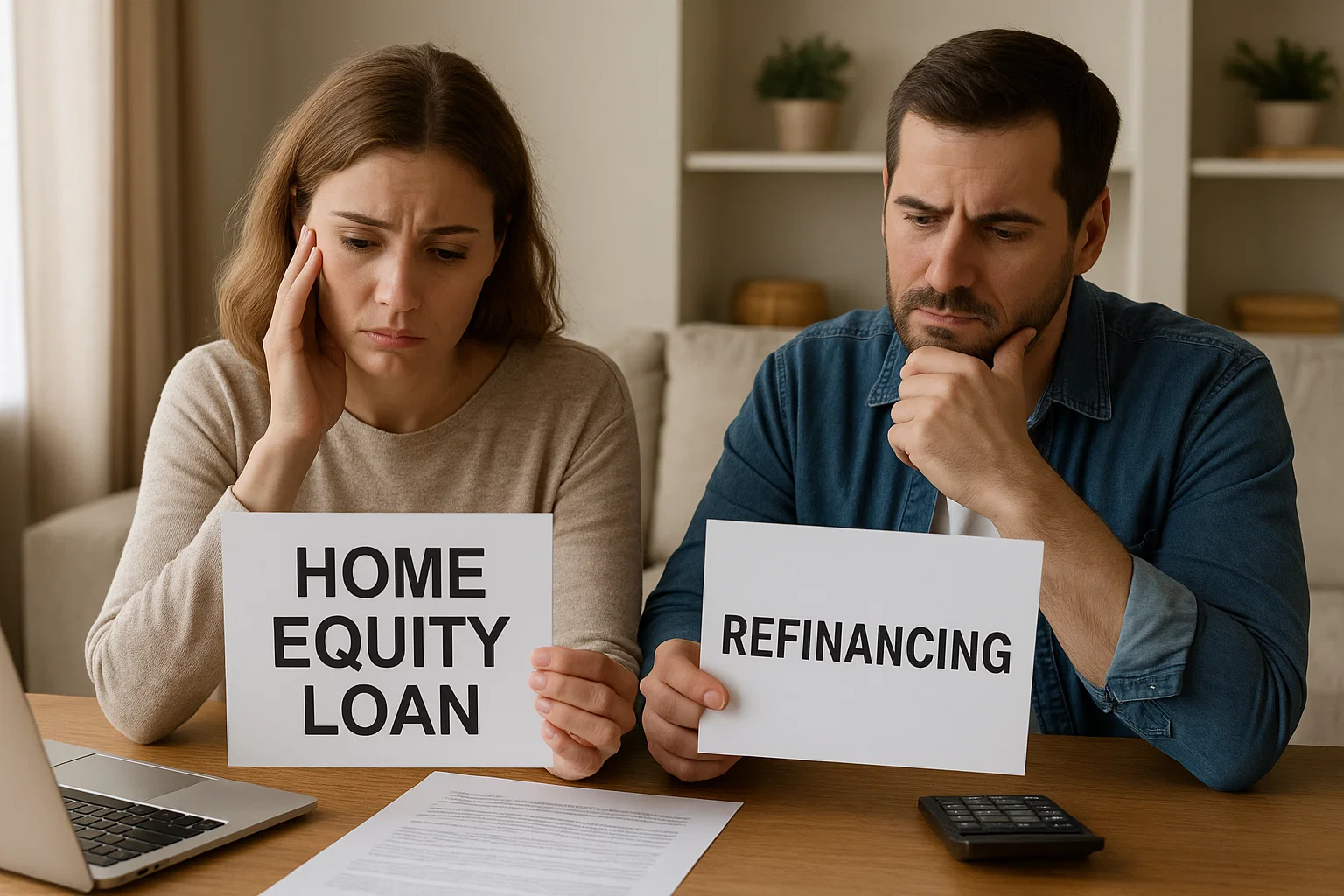Refinance Second Mortgage Only: Your Guide to Lowering Payments
November 19, 2025
Learn how to refinance a second mortgage only to lower payments, access equity, or consolidate debt. Get your guide to better terms.

Thinking about a refinance 2nd mortgage? It sounds complicated, but it can be a really good way to save some money each month. Basically, you're replacing your current mortgage with a new one that has better terms. Maybe interest rates have dropped, or maybe your financial situation has changed. Whatever the reason, understanding your options for a refinance 2nd mortgage is key to making sure you get the best deal possible. We'll walk through what you need to know.
Key Takeaways
- Refinancing your mortgage means replacing your current loan with a new one, ideally with better terms like a lower interest rate or a different loan length.
- When considering a refinance 2nd mortgage, compare offers from multiple lenders to find the best interest rate, APR, and loan terms.
- Before applying, check your credit score and know your home's equity, as these factors heavily influence your loan approval and rate.
- Refinancing can help lower monthly payments, allow you to access home equity for cash, or consolidate debt, but it does come with closing costs.
- Always review all loan documents carefully, especially the Closing Disclosure, to ensure you understand all the terms and fees before signing.
Understanding the Basics of Refinancing a Second Mortgage

What Does Refinancing a Second Mortgage Mean?
So, you've got a second mortgage, maybe a home equity loan or a HELOC, and you're wondering about refinancing it. What does that actually involve? Think of it like swapping out your current second mortgage for a brand new one. You apply for a new loan, and if it's approved, that new loan's job is to pay off your old second mortgage. The new loan will come with its own set of terms – a new interest rate, a new monthly payment, and a new repayment period. It’s a way to change up your existing loan for one that might fit your financial situation better right now.
Key Differences: Second Mortgage vs. Refinancing
It's easy to get these terms jumbled up, but they're not the same thing. A second mortgage is an extra loan you take out using your home as collateral, while you still have your primary mortgage. It sits behind the first mortgage in terms of repayment priority if something goes wrong. Refinancing, on the other hand, is the process of replacing an existing loan with a new one. You can refinance a second mortgage by itself, or sometimes you might look at refinancing both your first and second mortgages together, though that can be a bit more involved.
- Second Mortgage: An additional loan secured by your home, subordinate to the first mortgage.
- Refinancing: The act of replacing an existing loan with a new one, usually to get better terms.
- Refinancing a Second Mortgage: Replacing your current second mortgage with a new one.
When Does Refinancing a Second Mortgage Make Sense?
Deciding if refinancing your second mortgage is the right move really comes down to your personal financial goals and current situation. Are interest rates lower now than when you got your original loan? If so, refinancing could save you money on interest over time. Maybe your credit score has improved, opening the door to better rates. Or perhaps you want to change from a variable interest rate to a fixed one for more predictable payments. It can also make sense if you want to consolidate debts or tap into your home's equity for a large expense.
Before you jump in, it's smart to look at your current loan details. What's the interest rate? Are there any fees for paying it off early? Knowing this helps you figure out if a new loan will truly be a better deal.
Here are a few common scenarios where refinancing a second mortgage might be a good idea:
- Lowering Monthly Payments: If current interest rates are lower, you might get a new loan with a smaller monthly payment, freeing up cash flow.
- Switching to a Fixed Rate: If your current second mortgage has a variable rate that's unpredictable, refinancing to a fixed rate offers stability.
- Consolidating Debt: You might combine your second mortgage with other debts into a single, potentially lower-interest loan.
- Accessing Home Equity: A cash-out refinance on your second mortgage could provide funds for home improvements, education, or other major expenses.
Benefits of Refinancing Your Second Mortgage
So, you've got a second mortgage and you're wondering if refinancing it is actually worth the hassle. Honestly, it can be a pretty smart move, especially if your financial picture has changed since you first took out the loan. It’s not just about getting a new piece of paper; it’s about potentially making your money work better for you.
Lowering Your Monthly Payments
This is probably the biggest draw for most people. If interest rates have dropped since you got your second mortgage, or if your credit score has improved, you might qualify for a lower interest rate. Even a small decrease in the rate can add up to noticeable savings each month. Imagine having an extra fifty or a hundred bucks in your pocket every month – what could you do with that? Maybe put it towards other debts, beef up your savings, or just have a bit more wiggle room in your budget. It’s like finding money you didn’t know you had.
Accessing Home Equity for Additional Funds
Refinancing isn't just about cutting costs; it can also be a way to get some cash out of your home. If your home's value has gone up, or you've paid down a good chunk of your mortgage, you might have more equity built up. A cash-out refinance lets you tap into that equity, giving you a lump sum. People use this for all sorts of things – maybe you've been dreaming of a kitchen remodel, need to pay for college tuition, or have some unexpected medical bills to cover. It’s a way to use the value you've built up in your home for immediate needs. This process involves replacing your existing mortgage with a new, larger one, with the difference being paid out to you in cash cash-out refinance.
Consolidating Debt Effectively
Got a few different debts hanging around, like credit cards or maybe a personal loan, all with those annoying high interest rates? Refinancing your second mortgage can be a way to roll all that debt into one single payment. You could potentially get a lower overall interest rate by combining those debts into your mortgage. This really simplifies things, making it easier to keep track of just one payment instead of several. Plus, it can save you a good chunk of money on interest over the life of the loan. It's a solid way to get your financial house in order.
Switching to a Fixed Interest Rate
If your current second mortgage has a variable interest rate, you know how those payments can jump around. It can be a real headache trying to budget when your payment amount isn't predictable. Refinancing gives you the chance to switch to a fixed-rate loan. That means your interest rate stays the same for the entire loan term, so your monthly payment is predictable. Knowing exactly what you'll owe each month makes budgeting so much easier and protects you if interest rates start climbing in the future.
Refinancing your second mortgage can offer a financial reset, potentially lowering your monthly expenses, providing access to funds for other needs, and simplifying your debt management. It's a tool that, when used wisely, can significantly improve your financial well-being.
Here's a quick look at how refinancing can help:
- Lower Interest Rates: Potentially reduce the overall cost of your loan.
- Predictable Payments: Switch from a variable rate to a fixed rate for easier budgeting.
- Cash Access: Tap into your home equity for large expenses or emergencies.
- Debt Simplification: Combine multiple debts into a single, potentially lower-interest payment.
It's important to remember that refinancing does come with its own set of costs, so you'll want to weigh these benefits against the expenses involved before making a decision.
Eligibility and Requirements for Refinancing
So, you're thinking about refinancing your second mortgage. That's cool. But before you get too far down the road, you gotta make sure you actually qualify. It's not just about wanting a lower payment; lenders have their own set of rules they stick to. Think of it like applying for a job – they want to see if you're a good bet.
Checking Your Eligibility Criteria
First off, lenders are going to look at your home's value compared to how much you owe on it. This is called your loan-to-value (LTV) ratio. Generally, they like to see this ratio at 80% or less. So, if your house is worth $300,000 and you owe $200,000 on your first mortgage and $50,000 on your second, your total debt is $250,000. That puts your LTV at about 83% ($250,000 / $300,000), which might be a bit high for some lenders. You need to have enough equity – basically, the difference between what your home is worth and what you owe – to make refinancing work.
Understanding Credit Score and Equity Requirements
Your credit score is a big deal here. Most lenders want to see a score of at least 620 to even consider you for a refinance. If your score is lower than that, you might have a tough time getting approved, or you might end up with a higher interest rate than you were hoping for. It's worth checking your credit report and maybe working on boosting your score if it's on the lower side. On the flip side, if your credit score has gone up since you got your current second mortgage, that's a good sign! More equity is also a plus. Lenders feel more secure when there's a good chunk of your home's value that you actually own outright.
The Role of Your Debt-to-Income Ratio
Another thing lenders look at is your debt-to-income ratio, or DTI. This is basically a comparison of how much you owe each month on all your debts (like car payments, student loans, credit cards, and your current mortgages) versus how much you earn each month before taxes. If your DTI is too high, it signals to lenders that you might be stretched too thin financially, making it risky for them to lend you more money. Most lenders prefer a DTI of 43% or lower, but some might go a little higher depending on other factors.
Refinancing isn't just about getting a lower rate; it's about showing the lender you're a reliable borrower who can handle new loan payments on top of existing ones. They want to be sure you won't default.
Here's a quick rundown of what lenders typically look for:
- Credit Score: Aim for 620 or higher.
- Home Equity: Lenders usually want your total mortgage debt to be no more than 80% of your home's current value (LTV).
- Debt-to-Income Ratio (DTI): Keep this below 43% if possible.
- Income and Employment: You'll need to prove you have a steady income to cover the new loan payments.
The Process of Refinancing a Second Mortgage
So, you've decided refinancing your second mortgage is the way to go. That's great! Now, let's talk about what actually happens during the process. It's not as scary as it sounds, and honestly, it's pretty similar to refinancing your main mortgage. Think of it as a step-by-step journey to potentially better loan terms.
Reviewing Your Current Second Mortgage Terms
First things first, you gotta know what you're working with. Pull out the paperwork for your current second mortgage. What's the interest rate? Is it fixed or adjustable? What's the remaining balance? Are there any prepayment penalties if you pay it off early? Knowing these details is super important because it gives you a baseline to compare any new offers against. You don't want to jump into something new without knowing the specifics of what you already have. It's like going into a negotiation without knowing your starting point – not ideal.
Comparing Offers from Multiple Lenders
This is where the shopping around really kicks in. Don't just go with the first lender you talk to. Seriously, shop around! Different lenders will offer different rates, fees, and terms. You'll want to get quotes from at least three or four different places. Look at the Annual Percentage Rate (APR), not just the interest rate, because the APR includes most of the fees associated with the loan. Also, consider the loan length and any points you might have to pay upfront. Comparing offers helps you find the best deal for your situation and makes sure you're not overpaying. You can find some good options by looking at mortgage lender reviews.
Gathering Necessary Financial Documentation
Okay, now it's time to get your ducks in a row. Lenders are going to want to see proof of your financial stability. This usually means digging up documents like:
- Recent pay stubs
- Your most recent tax returns (usually the last two years)
- Bank statements (checking and savings)
- Proof of other income (if applicable)
- Details about your current debts
They'll use this information to verify your income, assets, and debts, and to assess your ability to handle the new loan. The more organized you are with your documents, the smoother this part of the process will be.
Completing the Application and Closing Process
Once you've chosen a lender and gathered your documents, you'll officially apply. This involves filling out a loan application and usually undergoing a home appraisal to determine your property's current value. If everything checks out and you're approved, you'll move on to closing. Before you sign the final papers, you'll receive a Closing Disclosure. This document details all the final loan terms, fees, and costs. It's really important to review this carefully and compare it to the initial Loan Estimate you received. After signing, there might be a short waiting period before the loan officially funds and your old second mortgage is paid off. And then, congratulations, you've got a new, potentially better, second mortgage!
The closing process involves a lot of paperwork, and it's easy to feel overwhelmed. Take your time, ask questions if anything is unclear, and make sure you understand all the terms and fees before you sign on the dotted line. It's your money and your home, after all.
Potential Risks and Costs of Refinancing
Refinancing your second mortgage can seem like a great way to save money or get some cash, but it's not always a walk in the park. Just like with any big financial move involving your home, there are definitely some downsides and costs to think about. You don't want to end up in a trickier spot than you started, so let's get real about the less-than-fun parts.
Understanding Refinance Closing Costs
First off, refinancing isn't free. There are fees involved, and they can add up pretty quickly. You're looking at things like appraisal fees to figure out what your home is worth now, title insurance to make sure there are no ownership issues, origination fees that the lender charges for processing the new loan, and a bunch of other closing costs. All these expenses can easily add up to somewhere between 2% and 5% of the total amount you're borrowing. It's a smart move to get a Loan Estimate from a few different lenders so you can really see what you're getting into with each one.
Here's a general idea of what you might encounter:
- Application Fee: This covers the initial work of processing your loan request and checking your credit. You might have to pay this even if your loan gets denied. (Typically $75 - $300)
- Loan Origination Fee: Charged by the lender or broker to set up your new mortgage. (Usually 0% - 1.5% of the loan amount)
- Points: One point equals 1% of your loan amount. You might pay these to get a lower interest rate (discount points) or because the lender charges them. You can often negotiate the number of points. (Can range from 0% - 3% of the loan amount)
- Appraisal Fee: Pays for an appraiser to determine your home's current market value. (Typically $300 - $500)
- Title Insurance: Protects the lender (and sometimes you) against claims on your property's title. (Varies, but can be several hundred to over a thousand dollars)
Many lenders give you the option to roll these costs into your new loan. This means you don't have to pay them out of pocket right now, which is nice. But, it also means you'll be borrowing more money and paying interest on those costs for the entire life of the loan. You really need to figure out if the savings you get from refinancing are actually worth these upfront expenses.
Calculating Your Break-Even Point
A good way to figure out if refinancing makes financial sense is to calculate your break-even point. This is basically the number of months it will take for the money you save each month on your new loan to cover all the costs you paid to refinance. If you plan on staying in your home for longer than that break-even period, then refinancing is likely a good financial move. If you think you might sell your house before you reach that point, you might end up losing money overall.
It's easy to get caught up in the idea of lower monthly payments, but don't forget to look at the total picture. Those closing costs can be significant, and if you don't stay in the home long enough to recoup them through savings, you might be worse off than before.
Impact of Refinancing on Your Credit Score
When you apply to refinance, lenders will check your credit report. This is called a "hard inquiry," and it can cause a small, temporary dip in your credit score. Usually, this isn't a huge deal, especially if your credit score is already pretty good. However, if you apply with several different lenders in a short amount of time, those multiple inquiries could have a more noticeable effect on your score. It's generally best to shop around for your loan within a concentrated period (like a week or two) so that credit scoring models often treat multiple inquiries for the same type of loan as a single event.
Long-Term Financial Implications
Refinancing can change your financial situation in the long run. If you extend the term of your loan, even with a lower interest rate, you might end up paying more interest overall. On the flip side, if you shorten your loan term, your monthly payments might go up, but you'll pay off your mortgage faster and save a lot on interest. Also, if you do a cash-out refinance, you're essentially taking out more debt. While that cash can be helpful for other expenses or debts, it increases your total mortgage balance and the amount you owe on your home.
Choosing the Right Lender for Your Refinance

So, you've decided refinancing your second mortgage is the way to go. That's great! But before you jump into signing anything, you've got to do a little homework. It's all about shopping around and making sure you're getting the best deal possible. Think of it like picking a contractor for a big home project – you wouldn't just go with the first one you find, right? Same idea here.
What to Look for in a Mortgage Lender
When you're comparing lenders, don't just look at the interest rate. That's important, sure, but it's not the whole story. You need to consider a few other things to make sure you're picking a lender that fits your needs.
- Interest Rates and APR: Obviously, you want a low interest rate. But also look at the Annual Percentage Rate (APR). The APR includes the interest rate plus most of the fees and other costs associated with the loan, giving you a more accurate picture of the total cost.
- Fees and Closing Costs: Every lender will have fees. Some might charge higher origination fees but have a lower interest rate, while others might do the opposite. Ask for a detailed breakdown of all costs, like appraisal fees, title insurance, recording fees, and any points you might pay to lower the rate.
- Loan Terms and Options: Does the lender offer the type of loan you need? Are you looking for a fixed rate or an adjustable rate? What are the repayment terms? Make sure they have options that align with your financial goals.
- Customer Service and Reputation: How easy is it to get in touch with them? Do they have good reviews? A lender with a solid reputation and good customer service can make the whole process much smoother.
The Importance of Lender Reviews
Reading reviews from other borrowers can be super helpful. It gives you a peek into what other people's experiences have been like. Were they treated fairly? Was the process transparent? Did the lender communicate well?
Checking reviews can save you a lot of headaches down the line. It's like getting a heads-up from friends about a restaurant before you go – you know what to expect.
Look for patterns in the reviews. If multiple people mention the same issue, it's probably something to pay attention to. Websites like the Better Business Bureau, Consumer Financial Protection Bureau (CFPB), and even general review sites can be good places to start. Just remember that everyone's situation is a bit different, so take individual reviews with a grain of salt, but look for overall trends.
Streamlined Online Application Processes
Nowadays, a lot of lenders have online platforms that make applying much easier. You can often upload documents, track your application status, and communicate with your loan officer all through their website or an app.
Here’s what to look for in an online process:
- User-Friendly Interface: Is the website or app easy to navigate? Can you find the information you need without a struggle?
- Secure Document Upload: You'll be sending sensitive financial information, so make sure their system is secure.
- Clear Communication Channels: Can you easily ask questions and get timely responses through the online portal or via email/phone?
- Digital Tools: Some lenders offer online calculators or tools to help you compare different loan scenarios, which can be really handy.
Comparing offers from multiple lenders is key to finding the best refinance deal for your second mortgage. Don't be afraid to ask questions and negotiate. The more prepared you are, the better your chances of securing a loan that truly benefits your financial situation.
So, What's the Bottom Line on Refinancing Your Second Mortgage?
Alright, so we've talked a lot about refinancing your second mortgage. It's not some super complicated thing, but it does take some thought. Basically, you're looking to swap out your current second mortgage for a new one that hopefully has better terms, like a lower interest rate or a payment that fits your budget better. Remember to check your credit score, know how much your house is worth, and definitely shop around with different lenders to get the best deal. It might take a little homework, but saving money on your monthly payments can really make a difference in the long run. If you're still not sure about any of it, talking to a financial advisor or a mortgage pro is always a smart move.
Frequently Asked Questions
What does it mean to refinance a second mortgage?
Refinancing a second mortgage is like getting a new loan to pay off your old second mortgage. You're basically swapping your current loan for a new one that might have better terms, like a lower interest rate or a different payment plan.
Why would I want to refinance my second mortgage?
People often refinance their second mortgage to get a lower monthly payment, which can free up money in their budget. It's also a good way to switch from a loan with a changing interest rate (variable rate) to one with a steady rate (fixed rate) that makes payments predictable.
Can refinancing my second mortgage help me get cash?
Yes, if your home's value has gone up or you've paid off a good portion of your mortgage, refinancing can let you take out some of that built-up value, called equity. This gives you a lump sum of cash you can use for things like home repairs or other big expenses.
What are the costs involved in refinancing?
Refinancing isn't free. You'll likely have to pay closing costs, which can include fees for things like appraisals, title searches, and paperwork. These costs can add up, so it's important to figure out if the savings from refinancing will be worth these initial expenses.
How does refinancing affect my credit score?
When you apply for a refinance, the lender will check your credit, which can temporarily lower your score a bit. However, as you make on-time payments on your new loan, your score should improve over time.
What do I need to qualify for a second mortgage refinance?
Lenders will look at your credit score, how much equity you have in your home, and your income compared to your debts (your debt-to-income ratio). Generally, having a good credit score, enough home equity, and manageable debt will help you get approved.













Get in touch with a loan officer
Our dedicated loan officers are here to guide you through every step of the home buying process, ensuring you find the perfect mortgage solution tailored to your needs.
Options
Exercising Options
Selling
Quarterly estimates
Loans
New home

Stay always updated on insightful articles and guides.
Every Monday, you'll get an article or a guide that will help you be more present, focused and productive in your work and personal life.









.png)
.png)
.png)
.png)
.png)
.png)
.png)
.png)
.png)
.png)
.png)
.png)
.png)
.png)
.png)
.png)
.png)
.png)